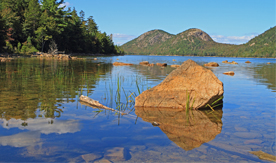Crowdsourcing Data

A new app developed by a University of Maine graduate student allows iPhone users to take water quality measurements.
“The end result we want is to crowdsource water quality data,” says the 23-year-old oceanography student from Lincoln, Vt.
As part of his master’s thesis, Thomas Leeuw developed HydroColor, an app that uses three photos to measure the reflectance of natural water bodies. Based on the reflectance values, the turbidity or level of suspended sediment in a given water body can be measured.
“What we’re measuring is the reflectance of the water and the particles inside it,” Leeuw says. “To make reflectance measurements, oceanographers use precision instruments called radiometers. HydroColor is taking what a lot of ocean scientists do with radiometers and satellites, and applying it to an iPhone camera.”
The process requires three photographs, beginning with a photographer’s gray card, which calibrates the app based on how much ambient illumination is present. Gray cards reflect 18 percent of the light in the area, giving the app an initial reading of how much light is entering the water.
Next, the app directs the user to take a photograph of the sky. The app uses this image to control for the amount of light from the sky that is being reflected by the surface of the water. Surface reflection — such as the blue color seen when looking at a body of water on a clear day — offers no information about the turbidity of the water because it is light reflected by the surface of the water, not reflected from particles suspended in it.
The final photograph taken is of the water itself, which the app evaluates after controlling for surface reflection. The magnitude of reflected light in the red portion of the visible spectrum can be used to assess turbidity.
The reflected light can also offer information about the type of particles in the water.
“Turbidity actually is a measure of sidescattering, but you can use it to estimate the concentration of particles, in grams per meter cubed, so we’re able to convert turbidity to physical values,” Leeuw says.
In addition, the makeup of particles can be inferred based on the color of light reflected. Organic particles typically contain pigments that absorb light only in certain regions of the visible spectrum. This will cause the reflectance signal to vary across the visible spectrum. Inorganic particles do not contain pigments and their reflectance signature does not vary greatly across the visible spectrum.
By aggregating data from many people over large spatial and temporal scales, HydroColor can determine the typical turbidity or chlorophyll values for different environments. The interactive online database can then be used by laypeople or lake association officials to help monitor for changes, such as increased occurrence of algal blooms or erosion leading to higher suspended sediment.
Turbidity is one of many parameters for measuring water quality. Chlorophyll, for instance, reflects mostly green light and can offer a measure of the amount of algal particles in the water body. Using the different reflectance characteristics, Leeuw says HydroColor could be expanded to offer a more comprehensive readout of water quality measurements.
Leeuw next hopes to find an online host for user-gathered water quality data. “Eventually we’re going to have a button in the app so after you take a measurement, you can upload it to an online database,” he says. “The idea is that the database is open to everyone, it is a place where people can look at and compare measurements from all over the world.”
Understanding how water quality parameters like turbidity change over time is critical for scientists in many fields, Leeuw says. “One turbidity level is not necessarily better than another. We’re just very interested in fluctuations. It’s a tool for looking at changes in the environment.”
Leeuw hopes HydroColor will also provide an inexpensive, accessible learning tool for science classrooms. Compared to a professional radiometer, which can be cost-prohibitive for most classrooms, iPhones are becoming ubiquitous among students, and gray cards generally cost less than $5.
“It’s an extremely cheap lesson using a lot of technology. You can not only use it to learn about environmental science, but optics, technology and app development,” Leeuw says. “Right now, it is only for iPhone, but we’re thinking about hiring a developer to convert it to Android as well.”
Although he had experience programming before turning to app development, Leeuw had to teach himself Objective-C, the language used for the iOS platform. But developing HydroColor demanded more than learning a new programming language. The project has been in progress for about two years, a time span that has allowed Leeuw and his adviser, UMaine professor Emmanuel Boss, to gather hundreds of photos while on other excursions.
“We’d always be doing our other research, but then we’d run over and snap a few pictures to continue with development,” Leeuw says. “We used (research) trips of opportunity — anywhere we’d go, we’d make sure to grab some data.”
Those “trips of opportunity” have allowed Leeuw to aggregate images from all over the coast of Maine, Georgia and Washington, and many locations in the Arctic. Leeuw sailed to the Arctic with Boss as part of a project to study Arctic phytoplankton.
Now that HydroColor is available in the Apple app store, Leeuw’s goal is in sight. He presented his app to the Ocean Sciences Meeting in Honolulu in February and hopes to publish the project in a journal.
Contact: Margaret Nagle, 207.581.3745
